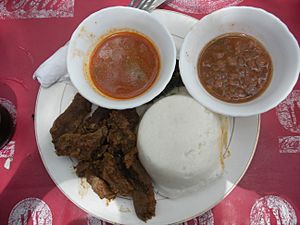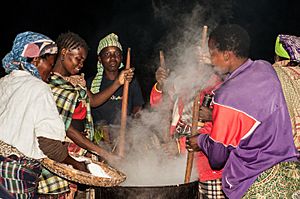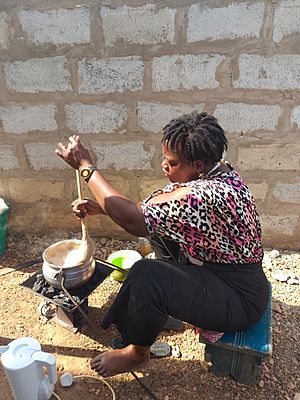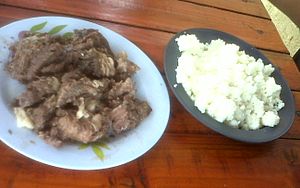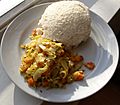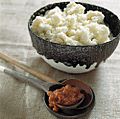Ugali facts for kids

Ugali and sukuma wiki (collard greens)
|
|
| Type | Swallow, porridge |
|---|---|
| Place of origin | Africa |
| Main ingredients | Cornmeal, mielie-meal (white maize) |
| Similar dishes | |
Ugali or sima is a popular type of thick maize flour porridge. It is a main meal in many parts of Africa. Sometimes, ugali is made from other flours. These include millet or sorghum flour. It can also be mixed with cassava flour.
Ugali is cooked in boiling water or milk. It becomes a stiff, dough-like food. In 2017, Ugali was added to the UNESCO Representative List of the Intangible Cultural Heritage of Humanity. This means it's recognized as an important part of human culture.
Contents
Many Names for Ugali
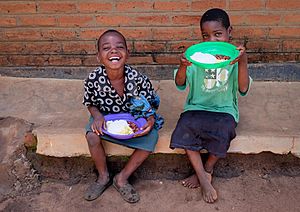
This special dish is eaten all over Africa. It has many different local names. Here are some of them:
- Agidi – Igbo, Nigeria
- Akple - Ewe, Akumè - Mina — Togo
- Busuma [Bukusu] - Kenya
- Bando – Soga, Uganda
- Bidia – DR Congo
- Bogobe/Phaletšhe – Botswana, South Africa
- Bugali – Burundi, DR Congo, Sudan, South Sudan Rwanda
- Buhobe – Lozi
- Buru – Kenya, Luo
- Busima – Bagisu, Uganda
- Chenge – Kenya, Luo
- Chima – Mozambique
- Couscous de Cameroon – Cameroon
- Dona
- Fitah – Sudan, South Sudan, Congo
- Foutou – Ivory Coast
- Fufu – Sierra Leone
- Funge de Milho - Angola (Northern)
- Sadza – Kalanga, Botswana and Zimbabwe
- Isitshwala – Botswana, Ndebele
- Isishwala - South Africa, Bhaca people
- Kawunga – Ganda, Uganda
- Kimnyet – Kalenjin, Kenya
- Kuon – Kenya, Luo
- Kwen wunga – Alur, Uganda
- Lipalishi – Eswatini
- Mdoko - Zulu, South Africa
- Mieliepap – Lesotho,' South Africa'
- Mogo – Kenya, Luo
- Moteke – DR Congo
- Mutuku – South Africa
- Nfundi – Congo
- Ngima – Kamba, Kenya, Kikuyu
- Nkima – Kenya, Meru
- Nshima – DR Congo Kasai region
- Nsima – Malawi, Zambia
- Obokima – Kenya, Kisii
- Obusuma – Kenya, Nyole
- Eko – Nigeria, Yoruba
- Oshifima – Namibia Ovambo
- Pap – Namibia, South Africa
- Papa/Bogobe – Lesotho, South Africa
- Pâte [French] – Togo
- Phuthu/phalishi – Zulu people, South Africa
- Pirão - Angola (Southern)
- Posho – Uganda
- Poshto – Uganda
- Saab – Ghana, Kusasi
- Sadza – Shona
- Sakora – Nigeria
- Sakoro – Ghana
- Sembe – Tanzania, Kenya slang
- Shadza – Kalanga, Botswana
- Shima
- Shishima – Zambia
- Sima – Chewa, Tumbuka, and Ngoni
- Soor – Somalia, Zambia
- Tuozafi (or T.Z.) – Ghana
- Tuwo - Hausa, Nigeria
- Ubugali – Rwanda
- Ubwali – Bemba
- Ugali – Kenya, Malawi, Mozambique, Tanzania, Uganda, Yao, Swahili
- Um'ratha – Ndebele people, South Africa
- Upswa – Mozambique
- Bohobe – Sotho, South Africa, Lesotho
- Vhuswa – Venda people, South Africa
- Vuswa – Tsonga people, South Africa
- Xima – Mozambique
Where the Name "Ugali" Comes From
The word ugali comes from the Swahili language. In Malawi, it's widely known as nsima. This name is used in languages like Chichewa and Chitumbuka. In some parts of Kenya, people might informally call it nguna or donee. The Afrikaans name (mielie)pap comes from the Dutch word for "(corn) porridge".
History of Ugali
Ugali became popular after maize (corn) was brought to Africa. The Portuguese introduced maize to Africa from the Americas between the 1500s and 1600s. Before maize, sorghum and millet were the main grains in most of Sub-Saharan Africa.
Farmers in Africa liked maize because it was easy to grow. It also produced much more food than sorghum. Over time, maize became the main grain in most areas. In Malawi, there's a saying: 'chimanga ndi moyo'. This means 'maize is life'.
Sometimes, nsima is still made from sorghum flour, but it's not very common. Cassava, another plant from the Americas, can also be used. It can be used alone or mixed with maize flour. In Malawi, cassava nsima is common near the lakes. But if maize harvests are bad, you might find it everywhere.
Different Kinds of Ugali
African Great Lakes Region
In the African Great Lakes region and Southern Africa, ugali is a very common staple food. When cooked as a thinner porridge, it's called uji. Uji is served with sweet potatoes, bananas, or bread. Solid ugali is usually eaten with vegetables, stew, or sukumawiki (also known as kale).
The traditional way to eat ugali is with your right hand. You roll a small piece into a ball. Then, you dip it into a sauce or stew with vegetables or meat. You can make a small dip with your thumb. This helps you scoop up the sauce or wrap it around meat. It's like using flatbread in other cultures. Leftover ugali can even be eaten with tea the next morning.
Ugali is not expensive, so many people can afford it. It's often eaten with a meat or vegetable stew. This makes a filling meal. Ugali is also easy to make. The flour can last a long time without spoiling.
Ugali in Ghana
Sagtulga (also called tuo zaafi) is a popular main dish in Ghana. It's eaten with soupy side dishes like okro soup. It's most common in the northern parts of the country. People usually eat it for dinner. But farmers and manual workers might have it for breakfast or lunch. It's often served with blended Corchorus olitorius leaves (called ayoyo) and okro. A stew is usually served on the side.
This dish is made from cooked maize dough. A little dried cassava dough and water are added. Traditionally, it's made with millet dough, which is native to northern Ghana. It's mainly eaten with green vegetable soup. This soup can be made from bitter leaves or fresh cassava leaves. Other soups like okra or groundnut soup can also be used.
Ugali in Kenya
In Luhya culture, obusuma (their name for ugali) is the main staple food. It's also important in Luhya wedding traditions. Obusuma made from millet was traditionally part of the special foods for a bride. Obusuma can also be made from sorghum or cassava. It's often served with vegetables, meat, fish, or thimena (small fish). For important guests, it's usually served with ingokho (chicken).
Ugali is made from ground white corn. It's similar to how tamales are made in Central America. In most homes, ugali makes up most of the meal. Vegetables or meat are served on the side. In wealthier homes, or for special events, ugali is served with lots of tasty vegetables and meats in a spicy gravy. It's a bit like mashed potatoes. In Kenya, you take a small piece of ugali in your hand. You press your thumb into the center to make a spoon shape. This lets you scoop up the sauce. Eating with your hands is a cultural tradition in the region.
Ugali in Malawi and Zambia

Nsima is a dish made from maize flour (white cornmeal) and water. It's a staple food in Zambia (where it's also called nshima or ubwali) and Malawi.
First, the maize flour is boiled with water to make a porridge. In Zambia, it simmers for a few minutes. Then, more flour is added, and it's stirred to make a thick paste. The cook uses a flat wooden spoon to stir the thick paste against the pot's side while it's still hot. Once cooked, the nshima or nsima is divided into portions. This is done with a wooden or plastic spoon dipped in water or oil.
Nsima is always eaten with side dishes, called "relish." These can be mushrooms, protein sources like game, beef, poultry, fish, or peanuts. Vegetables like pumpkin leaves, bean leaves, or cabbage are also common. In Zambia, sides are called ndiyo or umunani. In Malawi, protein dishes are ndiwo, and vegetable sides are masamba. These dishes are usually grilled or made into a stew. Dried fish or dried vegetables are also often eaten with nsima. Hot peppers or chili sauces are usually served with the meal.
Traditionally, people sit around a table or on the floor. They wash their hands before eating, as nshima or nsima is eaten with bare hands. This is done with a bowl of water. Or, a host might pour water over the hands of older people or guests. To eat, you take a small lump in your right palm. You roll it into a ball and dip it into the relish. Using your right thumb to make a dip in the ball helps scoop up the sauce. In Zambia, umuto means the sauce of a side dish. Scooping a lot of it with nshima is called inkondwa. As with many African traditions, age is important. Washing hands and eating usually start with the oldest person first.
Nshima or nsima is usually cheap and easy for most people to buy.
Ugali in Nigeria
In Nigeria, akamu, ogi, or Koko is a thinner porridge, like pudding. Ogi or Akamu is often eaten with "moin moin", a bean pudding, or "akara", a bean cake.
There's also a thicker version, called Eko by the Yorubas and Agidi by the Igbos. This thick pudding is cooked until it's firm. It's traditionally wrapped in leaves. The Yorubas call these Ewe Eran, and the Igbos call them Akwukwo Elele. It's usually eaten with different vegetable soups and sauces for a light meal. It can also be eaten with beans or bean products.
Ugali in South Africa
Pap, also known as mieliepap, is a traditional porridge or polenta in South Africa. It's a staple food for many African people in Southern Africa. The word pap comes from Dutch and simply means "porridge". It's made from maize-meal (coarsely ground maize).
Many traditional Southern African dishes include pap. There's smooth pap (slap pap), very thick pap that can be held (stywe pap), and a dry, crumbly phuthu pap. Phuthu dishes are often found near the coast in South Africa.
Different tasty side dishes can be eaten with pap. These are often made from green vegetables and spiced with chili. In northern South Africa, people eat pap for breakfast with milk, butter, and sugar. They also serve it with meat and tomato stew (usually tomato and onion) for other meals. When they have a braai (barbecue), Bogobe or Stywe (stiff) pap with a savory sauce is an important part of the meal. Phuthu pap is popular with boerewors (a type of sausage). This combination is known as pap en wors.
In the Cape Province, pap is mostly a breakfast food. Since maize-meal is cheap, poor people often eat it with vegetables. It can be served hot or fried after it cools. Phuthu porridge is sometimes enjoyed with chakalaka (a spicy vegetable relish) as a side dish at braais. In the northern provinces, pap is usually soft. It's made using fermented maize batter. This helps it last longer in the hotter climate.
Uphuthu is a South African way of cooking mealie meal. The result is a fine, grainy meal. It's usually eaten with vegetables and meat in the KwaZulu-Natal and Eastern Cape regions. Or, it can be the main dish with amasi (sour milk). Some people add sugar to uphuthu and amasi for a sweet treat, like cereal. But usually, it's eaten plain with amasi.
Phuthu or Uphuthu is a traditional way to prepare maize meal in South African cuisine. It's a crumbly type of pap or porridge. Most cultural groups in South Africa eat it. Phuthu is often eaten with meat, beans, gravy, and sour milk.
The texture of uphuthu often decides what dishes go with it. For example, amasi is usually eaten with a finer phuthu. Stews and curries are often served with a clumpier, stiffer phuthu. Very dry phuthu is often served with stews or leafy vegetables that have moisture. This dry phuthu would not be good with amasi, because it would become a paste.
Ugali in Zimbabwe
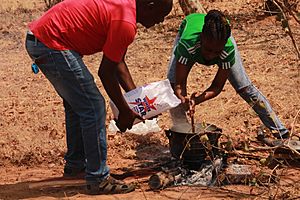
Isitshwala in isiNdebele or sadza in Shona is cooked maize meal. It is the staple food in Zimbabwe.
Isitshwala is made with finely ground dry maize (mealie-meal). This maize meal is called impuphu in Ndebele or hupfu in Shona. Maize was brought to Zimbabwe around 1890. But it has become the main source of carbohydrates and the most popular meal for local people. People buy the mealie meal in stores or grind their own maize at a mill.
Zimbabweans prefer white maize meal. But during times of famine, they might eat yellow maize meal. This is sometimes called "Kenya" because it was once imported from Kenya. Before maize, isitshwala was made from inyawuthi finger millet.
Isitshwala is usually served on individual plates. But traditionally, it was eaten from a communal bowl. Some families, especially in rural areas, still do this. It's generally eaten with the right hand, without forks or spoons. It's often rolled into a ball. Then, it's dipped into different foods like sauce/gravy, sour milk, or stewed vegetables.
Some foods eaten with isitshwala include:
- Meat: This includes beef, mutton, goat, and game meat.
- Cow hoof: Called amanqgina or mazondo.
- Oxtail
- Other foods: Intestines (tripe), offal (like lungs, liver, stomach), sun-dried vegetables (uMfushwa).
- White meat: Includes chicken meat and fish.
- Fish: Including small dried fish like Kapenta.
- Mopane worms: Edible moth caterpillars.
- Spring greens: Called imibhida in Ndebele, muriwo in Shona.
- Sugar Beans: Called indumba in Ndebele, nyemba in Shona.
- Cabbage
- Derere: okra.
- Cleome gynandra: (ulude in Ndebele) or nyevhe in Shona.
- Pumpkin: Leaves are called ibhokola in Ndebele.
- Soured milk: Natural yogurt, known as amasi or mukaka wakakora.
- Soya Chunks
- Soups and stews
- Ox bone
Dishes Like Ugali
There are other dishes around the world that are similar to ugali:
- Polenta from northern Italy.
- Gh'omi (ღომი) from Georgia.
- Grits in the southern United States.
Fufu, a food from West and Central Africa, can also be made from maize meal. When it is, it might be called fufu corn. In the Caribbean, similar dishes are cou-cou (Barbados), funchi (Curaçao), and funjie (Virgin Islands). It's known as funche in Puerto Rican cooking and mayi moulin in Haitian cuisine.
Other dishes similar to pap include banku, isidudu, uphuthu, umpokoqo, and umngqusho.
Images for kids
-
Ugali and cabbage
-
A meal of sadza (right), greens, and goat offal. The goat's small intestines are wrapped around small pieces of large intestines before cooking.
-
Ugali and usipa (small fish), staples of the Yawo people of the African Great Lakes.
See also
 In Spanish: Ugali para niños
In Spanish: Ugali para niños


